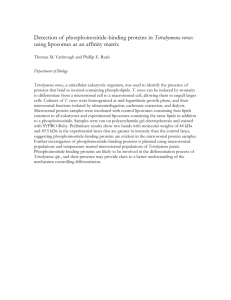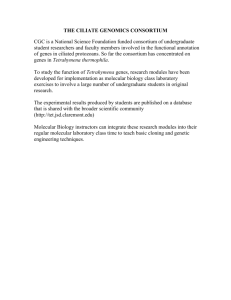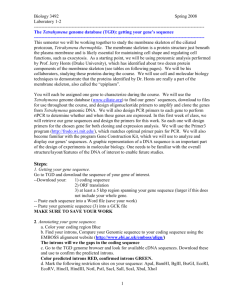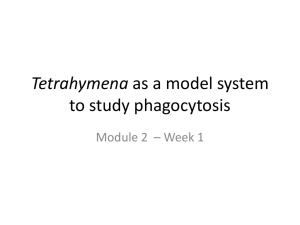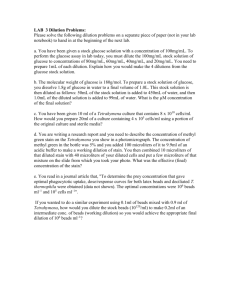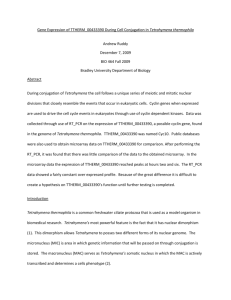NaCl Effect on Tetrahymena Phagocytosis: Lab Report
advertisement
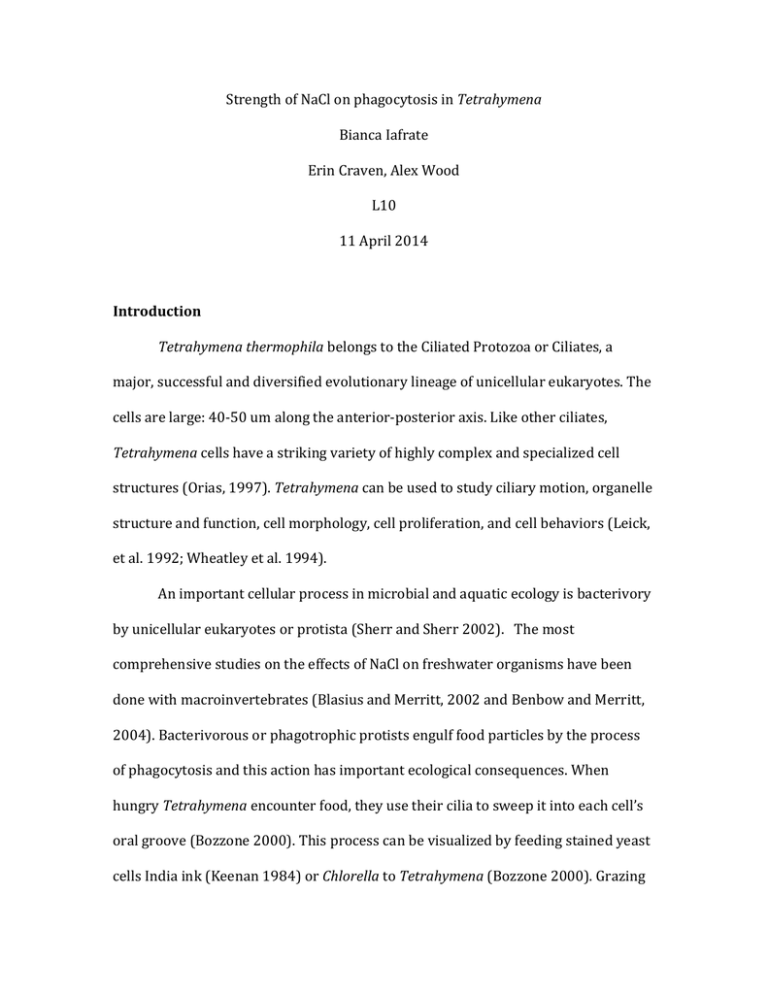
Strength of NaCl on phagocytosis in Tetrahymena Bianca Iafrate Erin Craven, Alex Wood L10 11 April 2014 Introduction Tetrahymena thermophila belongs to the Ciliated Protozoa or Ciliates, a major, successful and diversified evolutionary lineage of unicellular eukaryotes. The cells are large: 40-50 um along the anterior-posterior axis. Like other ciliates, Tetrahymena cells have a striking variety of highly complex and specialized cell structures (Orias, 1997). Tetrahymena can be used to study ciliary motion, organelle structure and function, cell morphology, cell proliferation, and cell behaviors (Leick, et al. 1992; Wheatley et al. 1994). An important cellular process in microbial and aquatic ecology is bacterivory by unicellular eukaryotes or protista (Sherr and Sherr 2002). The most comprehensive studies on the effects of NaCl on freshwater organisms have been done with macroinvertebrates (Blasius and Merritt, 2002 and Benbow and Merritt, 2004). Bacterivorous or phagotrophic protists engulf food particles by the process of phagocytosis and this action has important ecological consequences. When hungry Tetrahymena encounter food, they use their cilia to sweep it into each cell’s oral groove (Bozzone 2000). This process can be visualized by feeding stained yeast cells India ink (Keenan 1984) or Chlorella to Tetrahymena (Bozzone 2000). Grazing on bacteria can change the composition and activities of bacterial communities (Simek et al. 1997). In turn, this process can potentially alter biogeochemical pathways under the influence of bacteria (Prast et al., 2007). Large quantities of salt cause dehydration. Many fresh-water organisms are still able to thrive in lakes and rivers as winter comes to an end and road salts run into the bodies of water (low concentrations). Tetrahymena thermophila is a freshwater organism that commonly inhabits streams, lakes, and ponds. While freshwater lacks the presence of salt, seawater has a concentration of about 3.1% to 3.8% NaCl (varies). When put in different concentrations of salt-water solution, the fresh-water-thriving Tetrahymena will function the least in higher salt concentrations compared to lower salt concentrations, therefore consuming less. Materials and Methods Knowing that the Tetrahymena were fresh-water organisms, we knew that salt would be an interesting concentration to experiment with. We had eleven centrifuge tubes, labeled A through K, which were filled with 50 µl of NaCl solution that had concentrations of 0%, 10%, 20%, 30%, 40%, 50%, 60%, 70%, 80%, 90%, and 100%. With each concentration, 50 µl of Tetrahymena were added and allowed to adapt for ten minutes. 10 µl of blue polystyrene bead suspension was then added to each, and the Tetrahymena were allowed to feed for 10 minutes. 20 µl was then extracted from each tube and put into another tube, all again labeled A through K. To each, 20 µl of 0.2% glutaraldehyde was added to fix the Tetrahymena. We then took 10 µl from each solution and pipetted it onto separate slides and viewed under the microscope. 30 Tetrahymena were randomly chosen under a magnification of 10 and their contents of blue polystyrene beads were counted and recorded according to the concentration of NaCl they were in. Averages and standard error were calculated in Excel. Results 14 Average Numer of Beads 12 10 8 6 4 2 0 0% 10% 20% 30% 40% 50% 60% 70% 80% 90% 100% Concentrations of NaCl (%) (Figure 1: Average number of beads consumed by Tetrahymena in each NaCl concentration wi (+/- SE)) Tetrahymena phagocytized the most beads, 11.57(± 1.69, SE) in the 0% NaCl solution. At a concentration of only 10%, the Tetrahymena was extremely affected. The average intake of blue beads dropped to 0.3 (± 0.18, SE). In comparison, as NaCl concentrations increased to 10%, the number of beads phagocytized drastically decreased. In NaCl concentrations of 10% and 20%, Tetrahymena consumed few than one bead (0.3± 0.18, 0.27± 0.18, SE, respectively). In all NaCl concentrations over 20% up to 100%, no beads were phagocytized. Discussion Our initial observations included that the Tetrahymena moved very quickly and rapidly, with a lot of movement in general. Their eating habits included some eating to the point that they were full, while others did not eat at all. Going into the experiment, there was a chance that some would not feed. However, we did not expect for numbers to decrease so rapidly when increasing the amount of NaCl. Our hypothesis was supported, overall. The Tetrahymena functioned best in the three lowest concentrations (0%, 10%, 20%) of NaCl, and had no function at all in the other NaCl concentrations (30% through 100%). At this point, the question to ask would be: At which concentration, specifically, did the Tetrahymena lose all ability to function? Tetrahymena become stressed in NaCl concentrations, which makes sense because they are freshwater organisms. With such a dramatic drop in the feeding count, it could be possible that we did not count enough Tetrahymena in each tube. Not being given enough time could be why they were unable to function efficiently enough to carry out phagocytosis. If we had randomly selected 40 or 50 Tetrahymena to count, we could have found more in-take of the blue beads. In a future experiment, more should be counted. Using multiples of 10 as our NaCl concentrations could have also contributed to our results. Changing the numbers used could definitely change the results significantly. In a future experiment, instead of using 10%, 20%, 30%, etc., increments between concentrations should be 2%. You would test at exactly what concentration between 20% and 30% the Tetrahymena lost their ability to function, and when between 0 and 10 it begins to decrease. Also, you could see when it decreases between 10 and 20. Perhaps they lost function ability closer to 20% (21% or 22%) or as they got closer to a concentration of 30% (28%, 29%). Works Cited Benbow, M.E. and Merritt, RW. 2004. Road-salt toxicity of select Michigan wetland macroinvertebrates under different testing conditions. Wetlands, 24:68-76. Blasius, B.J. and Merritt, R.W. 2002. Field and laboratory investigations on the effects of road salt (NaCl) on stream macroinvertebrate communities. Environ. Pollut., 120:219-231. Bozzone DM. 2000. Investigating phagocytosis in Tetrahymena: An experimental system suitable for introductory & advanced instruction. The American Biology Teacher 62(2):136-9. Leick, V. and P. Hellung-Larsen. 1992. Chemosensory behavior of Tetrahymena. BioEssays 14:161–66. Orias, E. Introduction to the Genetics of Tetrahymena. Genetics. 24 Mar. 2014. http://www.lifesci.ucsb.edu/~genome/Tetrahymena/genetics.htm#Tetrahymena Prast, M., A.A. Bischoff, U. Waller, R. Amann, and U.G. Berninger. 2007. Effect of ciliates on nitrification and nitrifying bacteria in Baltic sea sediment Mar. Ecol. Prog. 350:55–61 Sherr EB & Sherr BF (1992). Trophic roles of pelagic prostists: phagotrophic flagellates as herbivores. Arch. Hydrobiol. Beih. 37: 165-172. Simek, K., J. Vrba, J. Pernthaler, T. Posch, P. Hartman, J. Nedoma, and R. Psenner. 1997. Morphological and compositional shifts in an experimental bacterial community influenced by protists with contrasting feeding modes Appl. Environ. Microbiol. 63:587–595 St Denis CH, MDO, Pinheiro, ME, Power, and NC, Bols. 2010. Effect of salt and urban water samples on bacterivory by the ciliate, Tetrahymena thermophila. Environmental Pollution. 158(2):502-7.
